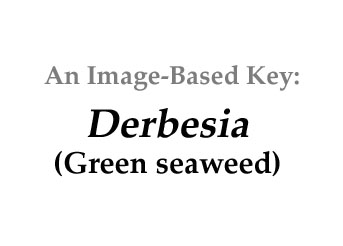|
|
||||
|
Click
on images for larger format |
||||
Name derivation: |
||||
|
|
||||
|
Classification: |
||||
Derbesia Solier 1846; there are 31 species of which 19 have been
taxonomically accepted currently (Guiry and Guiry 2013).
Order Bryopsidales; Family Derbesiaceae
|
||||
Morphology: |
||||
|
Kornmann (1938)
initially showed that Halicystis ovalis and Derbesia marina were
life history phases of the same species. In the Northwest Atlantic D. marina
populations have two types of life histories (Sears and Wilce,
1970). One involves a direct recycling
by filamentous sporophytes (i.e. Derbesia), the
other, which is apparently rare, involves an alternation with a haploid
gametophyte (Halicystis ovalis). Sears
and Wilce (1970) also showed that Halicystis could be obtained in culture directly
from sporangia of D. marina
sporangia Both phases
are true coenocytes. Halicystis ovalis is
spherical to subspherical, stalked and attached by rhizoids
(siphons) that grow through holes in encrusting corallines (e.g. Phymatolithon laevigatum
(Foslie) Foslie (cf.
Figure -). It cells have numerous spherical to elliptical plastids with or
without pyrenoids, and its cell walls contain xylan. Derbesia marina is an
erect, dense, silky green brush-like tuft that attaches by rhizoids or a
penetrating basal system. Filaments
are dichotomously branched, and may have paired cross walls across each
filament above a fork. Plastids are lens-shaped and are numerous per
cell. Sporangia replace branches and
are ovoid to pyriform. Stephanokont
zoospores are large with up to 16 formed in each sporangium.
|
||||
Similar genera: |
||||
|
|
||||
Habitat: |
||||
|
In the Northwest Atlantic populations of Halicystis ovalis are rare and only
recorded from New Hampshire (Mathieson and Burns
1970) and the Passamaquoddy Bay area of eastern Canada (Tittley
et al. 1987). They grow attached to crustose coralline algae [e.g. Phymatolitho laevigatum
(Foslie) Foslie], often associated with Ptilota serrata Kützing
and Corallina officinalis
L. (cf. Figure -). Sporophytes
are common to rare and are either pseudoperennials
or aseasonal annuals; they occur on the open coast
in the lower littoral zone (are often sponge covered) to 4-20m, either on crustose corallines or as epiphytes on other algae (e.g. Phyllophora ).
They are able to regenerate from residual material growing within sponge
tissues.
|
||||
References: |
||||
|
Guiry, M.D. and G.M. Guiry 2013. AlgaeBase. World-wide
electronic publication, National University of Ireland, Galway. http://www.algaebase.org; searched on 2
August 2013. Kornmann,
P. 1938. Zur
Entwicklungsgeschichte von Derbesia
und Halicystis. Planta
28: 464-470.
Mathieson, A. C. and R. L. Burns 1970. The discovery of Halicystis ovalis (Lyngbye) Areschough in New England. J. Phycol. 6: 404-405. Sears, J. R.
and R. T. Wilce 1970. Reproduction and systematics
of the marine alga Derbesia
(Chlorophyceae) in New England. J. Phycol. 6: 381-392. Tittley, I., W. F. Farnham, G. R. South and D. Keats 1987. Seaweed commnities
of the Passamaquoddy region, southern Bay of Fundy, Canada. Brit. Phycol. J.
22: 313 (abstract). |
||||





